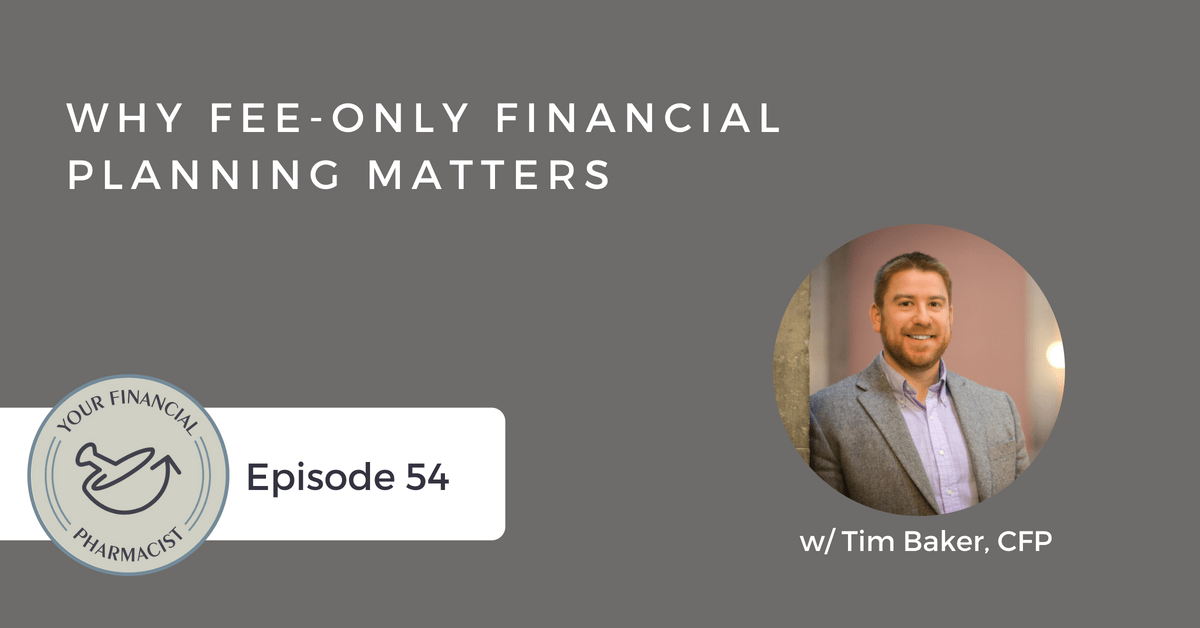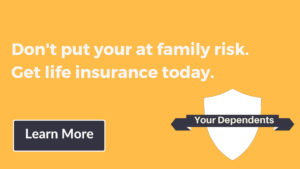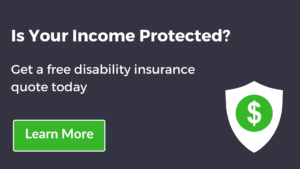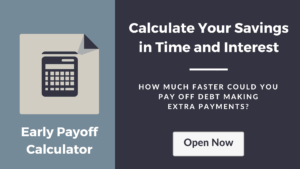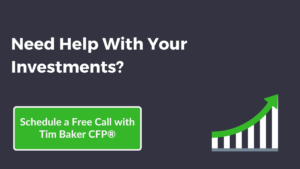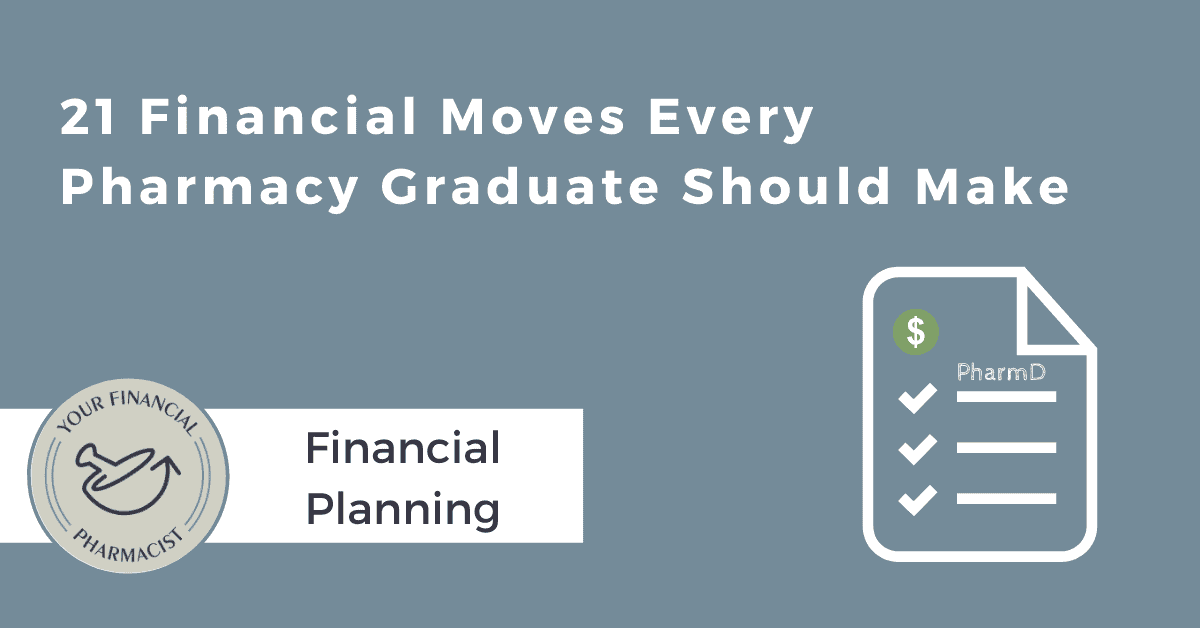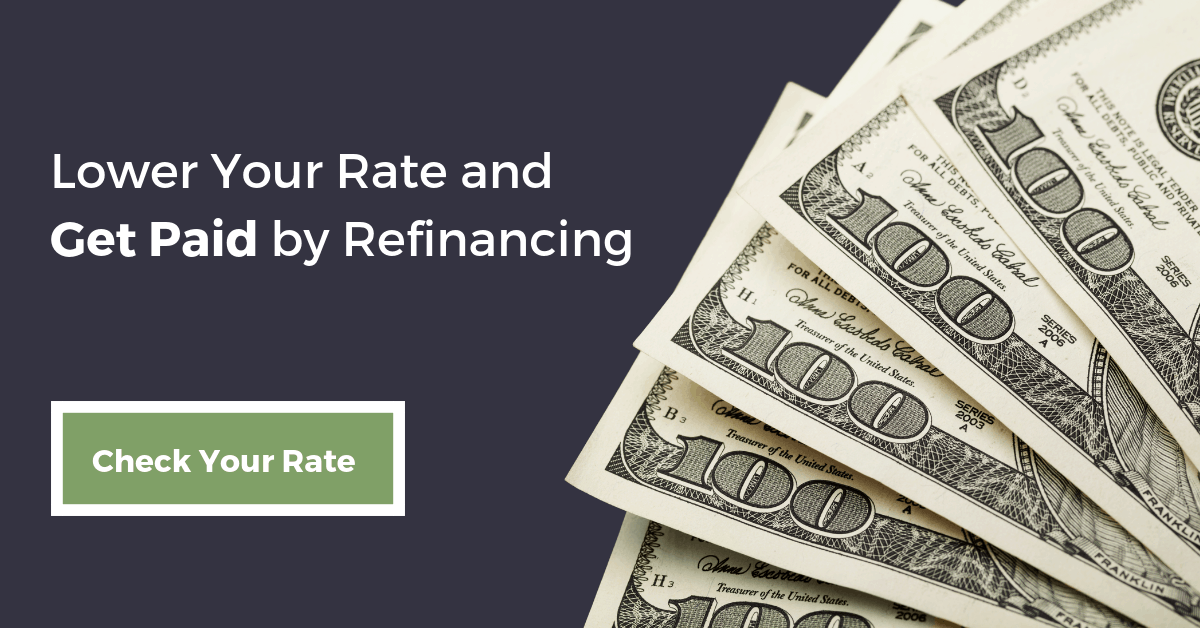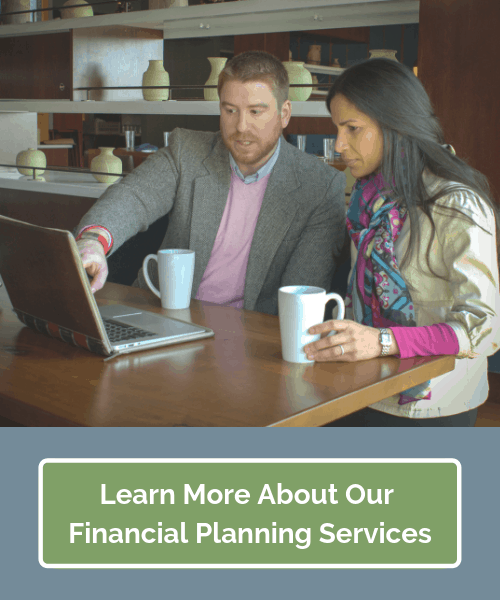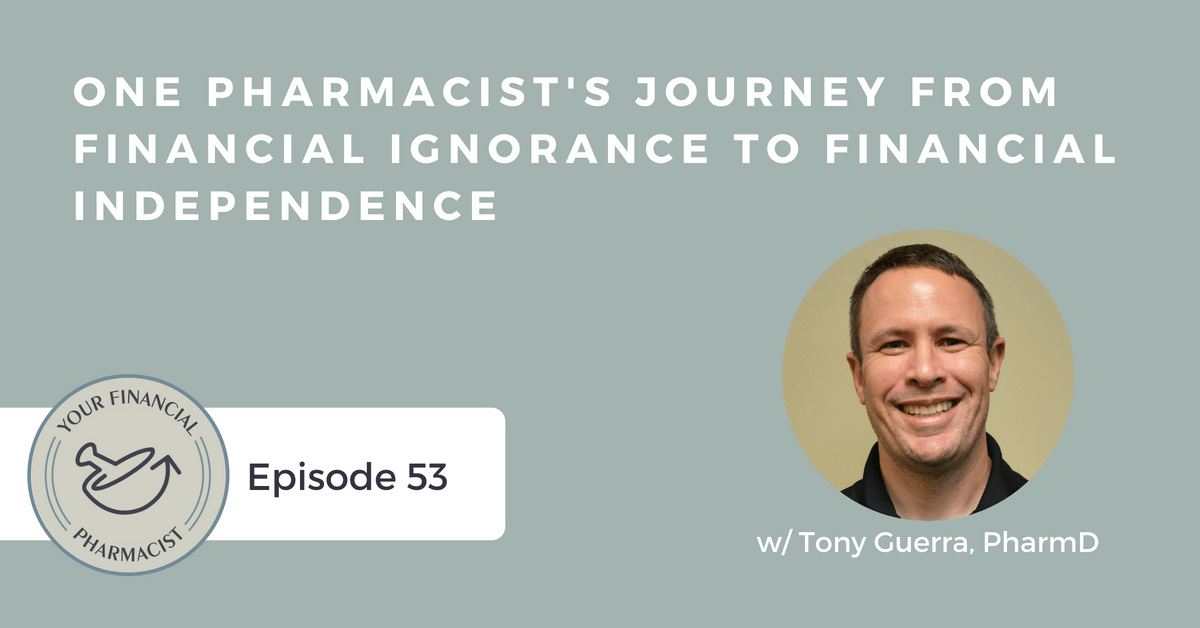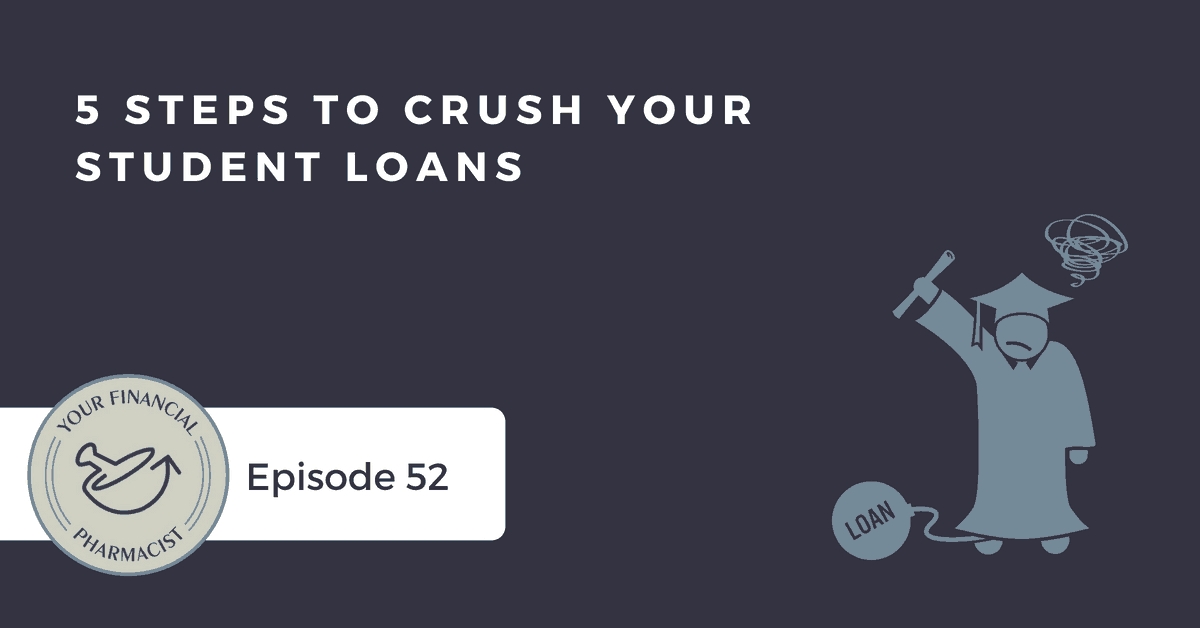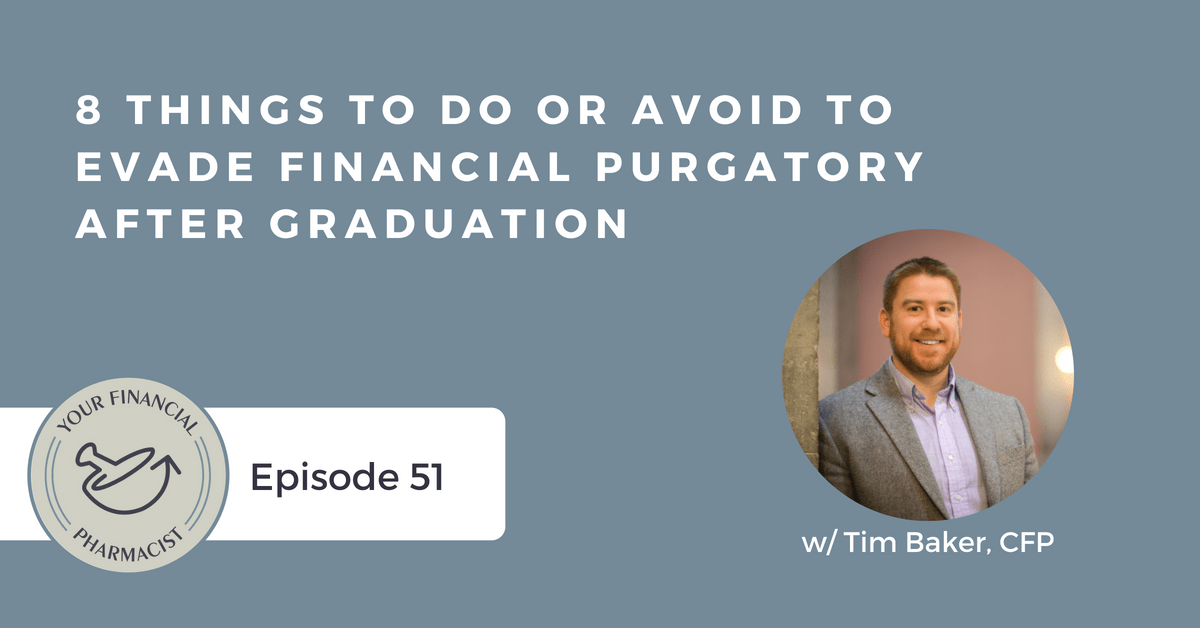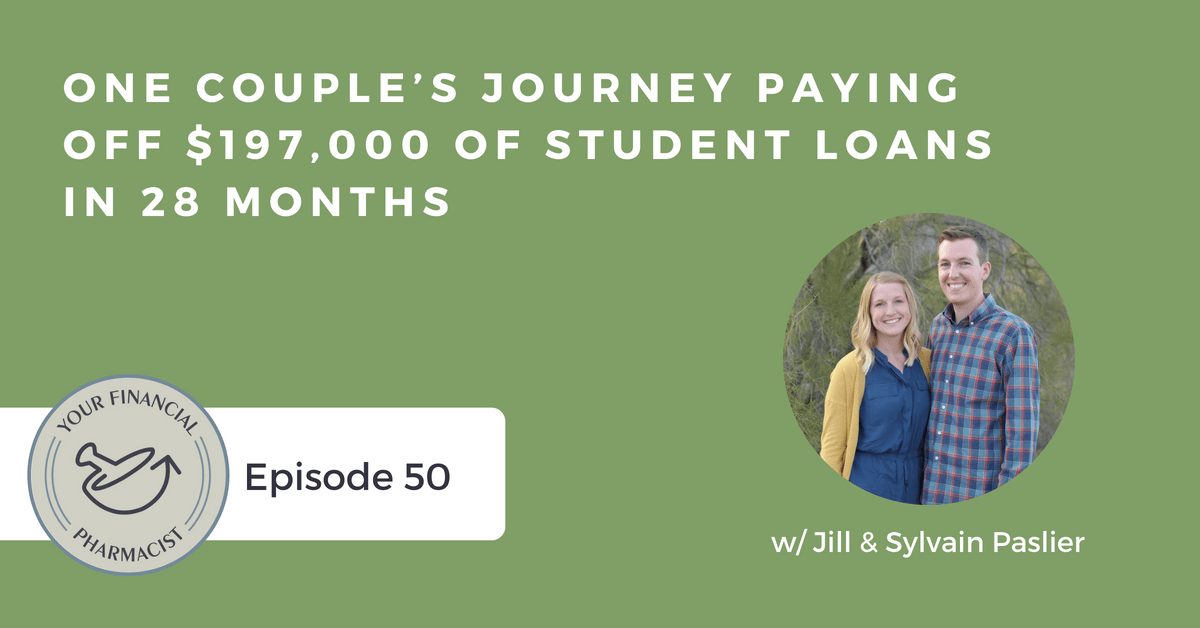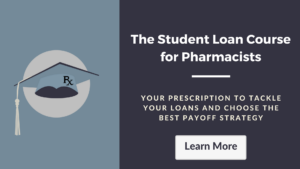On Episode 054 of the Your Financial Pharmacist Podcast, Tim Ulbrich, PharmD interviews YFP team member, owner of Script Financial and fee-only Certified Financial Planner, Tim Baker about why he left his old financial planning firm in 2016 to start Script Financial. Script Financial is a financial planning firm dedicated to helping pharmacists meet their financial goals. Tim & Tim talk through why fee-only financial planning matters and why a revolution of fee-only planning is happening today. Head on over to https://yourfinancialpharmacist.com/financial-planner to get information on what to look for in a financial planner, to download the free guide ‘Nuts & Bolts to Hiring a Financial Planner’ and to learn more about the financial planning services offered by Script Financial.
Mentioned on the Show
- Script Financial
- YFP Financial Planner
- YFP Episode 049: Ask Tim & Tim: Should I Pay Off My House Early or Invest?
- YFP Episode 015: Financial Planning Series Interview with Tim Baker Part 1
- YFP Episode 016: Financial Planning Series Benefits of a Financial Planner Part 2
- YFP Episode 017: Financial Planning Series Questions to Ask – Hiring a Planner Part 3
- YFP Episode 032: Find Your Why (Part 1) – 3 Life Planning Questions
- YFP Episode 033: Find Your Why (Part 2) – The Path to Success
- XY Planning Network
- XYPN Radio: XY Planning Network Podcast
Episode Transcript
Tim Ulbrich: Hey, what’s up, everybody? Welcome to Episode 054 of the Your Financial Pharmacist podcast. Excited to have Tim Baker back on the mic to talk this week and next week about financial planning, specifically why fee-only planning matters and why you should care about how a financial planner is making his or her money. So Tim Baker, here we are, Episode 054. And after a few solo episodes by both of us, a couple guest interviews, it was all the way back on Episode 049 when you and I last did a recording together and that was the Ask Tim & Tim episode where we tackled the question from Michael in Columbus about paying off a home early versus investing. So it feels good to be back together on the mic. How have things been in your world?
Tim Baker: Yeah, it’s been great. Actually, the last episode I think was Tony, right? Tony Guerra, that was the first episode that I didn’t hear until it actually went live. So we pass along editing duties to our assistant Kaitlyn, who is doing an awesome job, so it was kind of weird being a full-blown listener last episode. So I’m excited to be back and record this epsiode.
Tim Ulbrich: Yeah, we’re excited. This is such an important topic and one that we get so many questions about. And I should say, we did address financial planning in a mini-series we did, episodes 015, 016 and 017, we chronicled a little bit of your journey from West Point to becoming a CFP, we talked about the benefits of a financial planner, and then we also talked about questions that somebody should ask when hiring a planner. So we’re going to dig a little bit deeper into those topics here in Episode 054, and then next week, we’re going to jump in even further about how financial planners get paid and specifically why you chose the pricing model that you did in Episode 055. So before we dissect why fee-only financial planning matters and hear why you were convicted enough by this fee-only movement to jump ship from your old firm, let’s go all the way back for a minute to your journey into financial planning. And again, I know we talked a little bit about this in Episode 015, but give us your backstory, the Cliff Note version into why you chose financial planning as a career, especially since — as I remember — at the time, you had a very successful six-figure income and career. So why did you make that decision to jump to the financial planning industry?
Tim Baker: I think it’s actually analogous to why a lot of pharmacists get into pharmacy. I was at a point in my career where I was making, I was actually making good money, but I didn’t feel, I didn’t feel like warm and fuzzy after going to the office all day. You know, the best job satisfaction I got was when I was developing my key members. And I got to a point where money’s great, but I wanted to actually sit one-on-one and help people. And you know, when I left that six-figure job, I did some soul-searching, and I think I took about nine months off, you know, thereabouts, and you know, I just did some traveling and I reconnected because at that point in my life, I was so distracted — not distracted, but I was so involved in my career, and I didn’t really leave a whole lot of room for anything else, which was a problem. So I kind of tried to return to basics and reconnect with my roots, and you know, I was looking at different career paths and what I wanted to do. And both of my siblings — I have a sister who is two years younger and a brother who is two years older — and they both kind of in separate conversations said, ‘Hey, this is why I think you would be good in financial planning.’ And for me, it was kind of like an epiphany that I had when I went to West Point that, hey, maybe I think I really could be good at this and would enjoy a career here. And I was looking for something a little bit more entrepreneurial, which financial planning, it typically is. And that was kind of the path that led me back from the West Coast back to the East Coast and landed my first job in a financial planning firm.
Tim Ulbrich: And Tim, I remember actually, I think it was when you and I were still in our probably in our, let’s call it our dating phase period when we were getting to know each other, post-our initial meeting at Bob Evans a couple years ago. I remember, we were down at your sister’s place in Columbus, great area, great community involvement there. And I remember you telling that story about your siblings saying, ‘Hey, I really think you would be good at this industry, financial planning, because you really like to help people.’ And at the moment, I obviously didn’t know you well; I didn’t understand it. Now that Jess and I have had a chance to work with you as our financial planner and obviously as I’ve gotten to know you over the past couple of years in much more detail, I totally get it because I think your obvious strength, in my opinion, is relationship building and really caring and understanding about people and their situations. And we’ll talk more about that when we talk about why fee-only matters, but I think that’s one of the reasons it matters because you really allow the space for you to get to know your clients. We talk so much on the show that so much of financial planning is the factors beyond money, right? And I think you really understanding, for example, Jess and I and what motivates us, where we get stuck, where we’re frustrated, and it’s genuine. And I think that that relationship-building piece is so important when you think about a financial planner who’s not just somebody that’s really tactically looking at spreadsheets and adjusting things and rebalancing portfolios but really trying to understand who you are as a person to guide ultimately, then, your financial plan.
Tim Baker: Yeah, it’s one of those things — and to be honest, I didn’t really quite understand it even when I was getting into it. And probably some pharmacists think the same things, like they don’t really understand the profession until you’re actually, like, in it. Because I get a lot of, I do get a lot of sideways looks when I’m like, ‘Hey, I want to help people. I want to be a financial advisor.’ People are like, what? That doesn’t really sound like a calling. And I think what often happens — this is probably what we’ll get into a little bit it — I think sometimes the industry, with the sale of product and things like that and how compensation flows, sometimes it can muck that up a little bit. And you know, it’s like whose interests are first? And that type of thing. I think ultimately, you know, when I looked at it from a very pure standpoint, meaning — I’ll use pure instead of ignorance — I just, for me, I just thought, OK, I can sit down across the table from somebody and look at their situation and try to provide, you know, a semblance of a plan or a semblance of that I care about where they are and where they want to go. And I think a lot of what happens in the industry is that just because of how it’s structured, some of that can fall by the wayside. And to your point, like I’m a big believer in behavior and the relationship, and you know, really managing kind of like a life plan rather than just a financial plan. The finances are just really a tool. What’s the bigger picture? And you know, I think oftentimes, we as people, we just get so busy and so — and a lot of it’s just asking questions. Like I’ve said this before, I try to ask good questions and get the heck out of the way and just really you know, course correct a little bit and ask those questions and really hopefully it be a period of self-discovery. So it sounds kind of maybe hippie and you know, like, very touchy-feely, and I think you joked about that before. But again, a lot of these things aren’t things that we necessarily slow down to talk about and really self-reflect. And I think that’s where I can step in and hopefully provide a little bit of that, you know, catalyst to do that.
Tim Ulbrich: Yeah, spot on. And I remember even Tim Church and I talked about this when we were writing “The Seven Figure Pharmacist” book, and you know, obviously the title, “Seven Figure Pharmacist” implies a net worth of a million dollars or more, but we all know it’s not about just getting to a net worth of $1 million or more. I think if you crush your student loans, and you do awesome with your investments and home buying and other things you’re doing, ultimately, if there’s not a bigger plan or purpose there, I think people will find themselves disappointed. And I think that’s so much of what, in my opinion, people should be looking for in a financial planner — somebody who’s really going to help them pull out those pieces and parts like you and I talked about with Jess in Episodes 031 and 032 — I hope I have that right, somewhere around there.
Tim Baker: You’re better at that than me.
Tim Ulbrich: About finding our why, and I think that’s such a critical piece. So I have to be honest that as I started to think about this episode, I thought about all the pharmacists I’ve talked to over the last few years that, in my opinion, have appeared to somewhat aimlessly walk into a relationship with a financial planner. So what I mean by this is I hear a lot of pharmacists say and refer to their financial planner as ‘my guy’ or ‘my gal’ or maybe it’s somebody who mom and dad used and so by default, it’s going to be their same person. And of course, trust and relationships and knowing somebody’s important, but I’m fearful that there’s a lot of naive trust in that financial planner without really a full understanding of what value that person may or may not bring and whether or not they are actually obligated to be acting in the best interest — really understanding even how they get paid. I mean, would you say that’s a fair statement in terms of clients that you’ve talked with initially?
Tim Baker: Yeah, I think so. I think there’s a belief that all financial planners are created equal. And I would say this as full disclosure, this is not meant to be like a bask session. A lot of people that work in these capacities that are financial advisors or that work with mom and dad are, I think are pure at heart and want the best for their clients. I just think that there’s a better system to basically clear away some of the conflicts of interest. And for a lot of it — and I put myself in this bucket — you just don’t know any better. You know, I was into the industry, I was in the industry for quite a bit of time before I actually discovered the whole fee-only model and what that meant. But yeah, I would say that’s a true assessment, and what I try to explain is that it’s not apples-to-apples in a lot of ways. I’ll give you an example. You know, when I was at my last firm, what we typically did was cater to the pre-retirees and the retirees. And that’s what probably 90 percent of the financial planning firms out there do because the way that pricing model works is based on assets that you’ve accumulated over the course of your career. And that’s just basically how an advisor gets compensated is based on that number. And things like budgeting and student loans are not even really in the curriculum of the things you’re taught. You know, you’re taught more about stock options and things like that that for most — even most people, that doesn’t really matter. And things that have huge implications, especially towards the younger population — and I just remember kind of, you know, surprisingly asking questions about this and really no one knowing. And I’ve seen that with prospective clients where they’ll say, ‘Hey, I’ve been working with this advisor for a couple years, and I don’t really have a plan for my student loans.’ And some of the mistakes are you’re talking tens of thousands of dollars just because of you know, not having a clear strategy or not knowing what to do. You know, there was a conversation that I had about student loans, and they were like, ‘Oh, they just amortize over time, just like a mortgage would.’ I’m like — and at that point, I knew more than — I knew less than I do now but more than the other guys — and I’m like, no. And at that point, I’m like, I need to become an expert in this and really drill down as to what is going on with this because — and it’s not just pharmacists, it’s a lot of young people, especially with advanced degrees. And the fact that the industry I think in a lot of ways has failed in terms of providing good advice is a huge issue.
Tim Ulbrich: So you take your advice of the siblings, you go the financial planning route, you determine that’s the right career path for you, and you begin that first job. So tell us a little bit about that firm where you worked prior to then jumping to Script Financial in terms of the pricing model — and I know we talked a little bit about that in 015, 016, and 017, but what was that pricing model? And building on what you already said about where the interest may lie in terms of the client versus really the products and services that are being served?
Tim Baker: Yeah, so the first firm, it was an independent financial advisor firm. It was a solo practitioner, and he — I think he was ahead of the curve in a lot of ways. His niche was actually the LGBT community. He basically charged kind of very similar to what a lot of fee-based advisors charge. So a fee-based advisor is really, you can really in your quiver pick any way in which to charge the client for it to be profitable. So obviously, we’re talking about a business here. So the relationship needs to be mutually beneficial. You need to take care of the client, give them the financial products and plan and then obviously be able to run the business. So he typically would have the model of dependent on where the client fell in terms of assets and basically stage of life, that’s how he would basically determine how and when he would charge it. So to kind of give you an example, if you came in as a pharmacist and you had $150,000 in student loans but you have no assets to manage, he might charge you a flat, you know, a flat fee for a financial plan and give you advice that way. And then basically, the idea was when the assets were there, you kind of counted on that as an income stream. So as an example, you know, you get a financial plan, you work for a community pharmacist for five or 10 years, and then at that point, you know, you would count on the fact that if you left that job, you would be able to roll that money over into an IRA for him to manage. And then basically, it would be a percentage of that. Or in the meantime, you would sell that person insurance products or maybe a commissionable mutual fund that would pay the advisor 5% or whatever. And it would just be little dinks and dabs, like a little bit of — but the problem was is that it’s not clear to the consumer. So you’re like, OK, how are you charging me? Like you could charge me — he didn’t really do this — but you could charge me hourly. But it was commission, it was different products, it could be a flat fee for a plan. It was kind of all over the place, but then like once you reach a certain asset level, so if you work for that company for five years and you roll over let’s just say $100,000 just as an example, $50,000, then you would charge a percent based on that. But the problem with that model, Tim, is that typically what happens is that the people that pay the most in fee get the attention. So typically, if you’re working with your parents’ firm, and they’re paying x and you’re paying a quarter of x, you’re not going to get the attention. And that’s what often happens is that you just kind of, hey, i’ll buy you a mutual fund for your IRA every year, and then we might have a conversation. And then that’s it, and unfortunately, what the industry says is that, oh, you’re young, you don’t really have assets, there’s no need for a plan, there’s no need for advice, which is completely false. It’s more of a pricing issue than a planning issue if that makes sense.
Tim Ulbrich: Yeah, I love that, just the comment you made about where the attention goes. Follow the dollars, right? I even think about this as people may be considering a plan that their parents use. Again, it doesn’t necessarily mean someone is inherently not a good planner, but I think about the life stage my parents are in. They’re in a very much a wealth-building stage. And they obviously have a lot more assets to manage than I do, whereas I think about coming out of school, I didn’t know how to do a budget, I was $250,000 in debt, I didn’t have financial goals, like I need a lot of love and attention when I came out of school as do a lot of new practitioners, right? And is the pricing model set up in a way that’s going to allow that? And I think — and I might be getting ahead of myself here in a few minutes — but when you think about a fee-only model, if I’m paying you for your advice and your services, and that’s relatively similar to what somebody at the next stage of life is paying, you know, I have, then, the power, if you will, to say, hey, Tim Baker, I need your attention just as much as my parents do because you’re helping me in whatever stage I’m in, and you may be helping them in whatever stage they’re in. So you articulated well on a fee-based model, and I would agree with you in terms of it’s really hard to understand where the money comes from. And I think as you’re interviewing, as people in the YFP community are interviewing financial planners, if you find yourself confused about where the dollars are coming from, stop and make sure you get those questions answered because that probably means somebody’s not in the fee-only model.
Tim Baker: Yeah, and I remember, Tim, actually I think this was post-our Bob Evans first date, I think I remember you saying to me, ‘I’ve met with how many different advisors just to understand it, and you walk out of there and you have no idea like how it works.’ And I think you paid me a compliment that you did understand how I charge, and I brushed off my shoulder a little bit. I’m like, alright, I’ve got something here, no big deal.
Tim Ulbrich: So if in a fee-based model, it sounds like it could be a combination of commissions, it could be from insurance products, it could be from investments, it could be in assets under management, it could be a flat fee for a plan. What are the inherent problems, then, with a model that’s priced like that in terms of where the client’s best interests really may lie or not?
Tim Baker: Yeah, I know. It’s funny because I joke when I talk to prospective clients about this. And you know, I say, when people at my last firm would say, ‘Hey, Tim, how do you get compensated?’ usually, that’s a cringeworthy question for a lot of advisors because, you know, part of it is because it takes awhile to explain. Another part of it could potentially take awhile to explain, like I said, these are all different ways that a fee-based advisors has in their quiver to be able to charge people. It doesn’t mean that everybody uses them, but for me, a young planner, I’m just trying to figure out a way to be myself and make a business out of what I was doing. I’d basically say, pull up a chair because this is going to take me awhile to explain it. So it could be, like you said, it could be an hourly fee, it could be assets under management, which I explained was 1% or 2% of whatever the assets that you are physically managing. It could be a mutual fund commission where, hey, you know, Tim, it’s a — let me give you $5,500 to invest, and then I’m going to charge you, you know, 5% on that, so it’s a $275 haircut. Or it’s a C-share commission, which is a 1% annual thing, and it’s a little bit more spread out. But those are more expensive over time. It could be an annuity, it could be life insurance. And typically, the life insurance that pays the advisor more is better for the advisor and not necessarily good for the person that’s buying it. So it’s just a hodge-podge of things, I thought at the time it was kind of obvious, but it totally wasn’t in terms of how it actually worked. I’m like, oh, it’s just this and this and then that’s how it works. But then like the next year, it could change to base on their circumstances. So there really wasn’t a clear path forward. And just things like — you know, I remember getting started, I would be doing happy hours and I remember — so these mutual fund wholesalers come into your office and they say, they whip out the glossy and they say, ‘Hey, this is why you should be our funds,’ which might sound maybe some more like drug reps or things like that.
Tim Ulbrich: That’s what I was just thinking, yes.
Tim Baker: And then they say, and then they basically say, ‘Hey, let’s go out to lunch, and I’ll tell you the great things about what we’re doing at ABC Mutual Fund.’ And then it’s kind of like — and then at my point in the career, I was — they’re looking for, ‘Hey, Tim, how can I help you grow your business?’ And I’m like, ‘Well, I’m doing these happy hours, I’m just trying to generate interest, people to see me.’ And I remember this instance where the guy was like, ‘Well, I’ll foot half the bill if I can come and speak.’ And I’m like, ‘Yeah, that sounds great because money’s a premium, marketing’s a premium.’ But then afterwards, I kind of had, you have that slimy feeling like I’m in the pocket of this particular — and I know in a lot of business, we joke about Shay (?) and construction business, it’s kind of like that’s how business works. I don’t want to be beholden to anybody because they paid for a happy hour. So I just, I wanted to be free, just free of the product, free of like what I was choosing as the tools to implement and really keep the advice pure. And it can be difficult to understand because again, I think probably 95% of the industry, there is a conflict between the advice that you give and the product you sell, and it’s just not commonplace for the whole fiduciary, the whole separation of product and advice, it’s not commonplace in the industry.
Tim Ulbrich: And I think that’s why I struggled with it so much, just as a pharmacist and a healthcare provider, I very naively come from the mindset of you act in the best interest of the patient, period.
Tim Baker: Yeah.
Tim Ulbrich: That’s what you do. I mean, that’s what you do, right? And so you know, should have known better, but obviously as you look at the financial planning industry, very different just in terms of the models that are out there, and actually the vast majority of planners not having to legally act in the best interests of the client. But the example you gave of the pharmaceutical industry and pharma is spot on. I can remember during residency and after rotations, we’d have drug reps come into the office, and they’re presenting the research that was, of course, sponsored by the company. You know, they’re presenting on viewpoint, and obviously as the provider, like we’re obligated to step back and say, ‘What’s the whole body of research? What’s the evidence behind this?’ And I think it’s similar here is you have to follow the money trail. Where is the money going? And as we’ll talk about here in the second part of the show, in a fee-only model, the money is going to the planner for their advice, not for a product, not for a commission, not for insurance or investments, it’s going for their advice, everything from budgeting to paying off student loans to end-of-life planning and everything in between to really look at your plan in a comprehensive nature.
Sponsor: I want to take a brief moment before we jump into the second part of the show and to highlight today’s sponsor of the Your Financial Pharmacist, which is Script Financial. Now, you’ve heard us talk about Script Financial before on the show, YFP team member Tim Baker, who’s also a fee-only certified financial planner, is owner of Script Financial. Now, Script Financial comes with my highest recommendation. Jess and I use Tim Baker and his services through Script Financial, and I can advocate for the planning services that he provides and the value of fee-only financial planning advice, meaning that when I’m paying Tim for his services, I’m paying him directly for his advice and to help Jess and I with our financial plan. I am not paying him for commissions, I am not paying him for products or services that may ultimately cloud or bias the advice that he’s giving me. So Script Financial specifically works with pharmacy clients, so if you’re somebody who’s overwhelmed with student loans or maybe you’re confused about how to invest and adequately save for retirement or maybe you’re frustrated with just the overall progress of your financial plan, I would highly recommend Tim Baker and the services that he’s offering over at Script Financial. You can learn more today by going over to ScriptFinancial.com. Again, that’s ScriptFinancial.com.
Tim Ulbrich: OK, so here we are, Tim. You mentioned, you know, holding some of those happy hours, really starting to understand kind of that fee-based model, trying to avoid, you know, some of that slimy feeling and really wanting to be objective in the advice that you’re giving, so tell us a little bit about ultimately, the pivot point of why you made that decision to leave and then give us that introduction into starting Script Financial. And I’ll start there and even jump ahead and say, why pharmacists specifically?
Tim Baker: Yeah. That’s a great question. And I would say, kind of back up a little bit. You know, like where I was in an independent financial planning firm, like I thought we were the bees knees. Like I thought we were it because we weren’t a big wirehouse or some of these bigger banks that you hear, you know, some of the not-so-great behavior. And we’re better as an independent because we can sell non-proprietary products, meaning we can basically sell any products that are out there. So in my mind, I had landed first time in the best model that was out there. And what I — I wouldn’t say quickly — what I very slowly realized was that I wasn’t in the best model and that there was a little bit more work to be done there. So basically, what happened was I was going through, I was kind of growing, I was slowly growing my business, and I just started to naturally gravitate towards younger people. You know, I kind of just remember retirees, pre-retirees coming in, and I just didn’t connect with them at all, like I just didn’t — retirement was so far away, and it just seemed weird that I would be sitting there, you know, talking about Monte Carlo analysis and things like that or long-term care insurance. And I just didn’t get, like I didn’t feel engaged. So i just started to really gravitate towards younger people. And at that time, it was actually my brother — and my brother works in a completely different industry, but he is very entrepreneurial, and he was researching — he’s a developer, so he’s researching the financial advisor industry and trying to figure out if he could build software that basically helped the industry. And he interviewed a guy named Alan Moore, and Alan was, is a young CFP, and he was starting something called XY Planning Network. And what XY Planning Network is is a group of fee-only CFPs that basically cater to Generation X, Generation Y. So he brought them to my attention and said, ‘Hey, are you fee-only? Like how do you charge? How does it work?’ And at the time, you know, he was basically saying like, dude, you’re wrong. The way that you’re doing it right now, it doesn’t work. This is a better model. And you know, what do you do when your older brother basically is trying to like tell you about your business? I’m like, get out of here. Don’t tell me about how to run my business.
Tim Ulbrich: Go do your developing, right? Go do your whatever.
Tim Baker: Exactly. And then I started to like crack open the book of what fee-only was, and I just started to listen to XYPN radio, which is the podcast they have. It just kind of chronicled different firm owners who are young and kind of worked for other firms and maybe there wasn’t a clear path forward or they saw that, you know, fee-only was better. Maybe they came from the broker-dealer, commission, fee-based world that I did. And I just started to just cram these episodes. And you know, at that time, most of my clients were pharmacists — and I’ll tell the backstory in a second, but I just started to like — wheels started to turn for me, and I’m like, you know, if I’m not comfortable as the consumer doing what I’m doing, why would I position myself as this? So I just started kind of planning from there. And you know, I wanted to make sure — you know, typically when you Google ‘questions to ask your financial advisor,’ typically they’re going to say, are you a CFP? Which I was at that point, a Certified Financial Planner. And then, how do you get paid? And typically, the fee-only model is, they’re very vocal in terms of this is the best model because it reduces the conflict of interest. But there’s still some there; there’s no such thing as conflict-free advice, but that was kind of the early makings of Script Financial, at least in terms of planning and all that. So that’s kind of how that started.
Tim Ulbrich: So talk us a little bit more then, you make this jump, you identify fee-only’s where you want to be, and you say, ‘I’m going to really own the pharmacist space.’ Because what we’ve come to realize after you and I met is that nobody was really — I mean, there’s people that dabble in healthcare financial planning at large, couple people that are out there working with independent pharmacies as a group, but nobody that we know of really niched down and said, ‘I exclusively want to work with pharmacists.’ So talk about that.
Tim Baker: Yeah. So part of the — you know, and I give credit to XY Planning Network, one of their big things is it’s all about niche, you know, owning a niche and really being — because I think what often happens is that financial advisors, financial planners say, oh, like you have a pulse, I can work with you. And you become, you become master of none, you know? You’re very general, you’re a generalist. So working with somebody who is a retiree, like you said, your parents versus you, is very different. And so I started to think about that, and I was like, that makes a lot of sense. And by the way, I’m more drawn to younger people, that kind of Gen X, Gen Y, and you know, the millennial generation’s like 80 million, so that’s not really a niche. It is, in a sense, but you can niche down further. So when I started in the business, one of my first clients was a West Point classmate of mine. He got out of the Army, moved to Baltimore, and that’s really one of the reasons why I’m in Baltimore. I came for an Army-Navy game many, many years ago and really like Baltimore. And they became early clients and then his wife was a pharmacist. And I just started to get referrals through them, and I quickly found that my small client base was mainly pharmacists. So I’m hearing this podcast, I’m hearing niche, I’m hearing fee-only, and I think I was on a drive out to Ohio to visit my sister, and it just clicked for me. I’m like, I’m doing it. Like this is what I’m doing.
Tim Ulbrich: Those are great moments, aren’t they?
Tim Baker: Oh, man. And I guess that was an epiphany moment for me too. I typically say I’ve really only had two of those, but that’s probably the third one where I’m like, this is what I’m doing. And almost like unapologetically like focused on that because I would even — because a lot of my friends in Baltimore are pharmacists. We joke that if 10 of us go out, typically, there’s eight pharmacists and two are non-pharmacists. But even some of my pharmacist friends, they looked at me like I was crazy. But I was unapologetic. I’m like, to me, this is what I’m going to do. So I just started this — like I said before, this thousand cups of coffee. So I would just talk to every pharmacist that I could get my hands on and say, ‘Hey, pharmacist. This is my idea.’ Or maybe not say it that bluntly, but what are the things from a financial perspective that are really kind of top of mind? What’s troubling you? And at the time, it wasn’t readily apparent that the big things were, hey, I’m overwhelmed with student debt, like at least for me. Like I wasn’t completely bought into the niche. So what my research showed me was kind of some of those major pain points being, hey, Tim, I’m overwhelmed with my student loans. I’m really unsure about how to properly save or budget or just invest for my future. And then I feel frustrated because I make a good income, but I’m not progressing financially. And I think once I logged into that, that’s what I often say to a lot of prospective clients, and they’re like, ‘Wow, Tim, you just described me. Check all three of those boxes.’ And for me, that’s not something you’re going to get from a typical, run-of-the-mill, like if I was Baker Financial Planning, and I was basically servicing anybody that was alive, I wouldn’t have the attention to be able to say — and it’s funny, I was on a prospective call yesterday who actually heard you on one of your recent webinars. And he was talking to me, and he assumed that I was — he didn’t know which Tim he was talking to. So he assumed that I was a pharmacist, so he like started to talk, and he’s like, ‘Oh, are you a pharmacist? I don’t remember which Tim.’ And I’m like, ‘I’m not a pharmacist, but I’m tracking all that stuff because I talk to so many of you guys that I understand the language and I understand kind of the transition from P4 to PGY1 and then kind of new practitioners and beyond.’ So to me, I think, you know, embracing that niche — and what I saw in the market, to your point, Tim, was you know, a lot of advisors will go after doctors because there’s kind of that inherent, they make big incomes and everyone wants to kind of go after that demographic of people. And you know, pharmacists and dentists were kind of like throw-ins, you know what I mean? So there wasn’t anybody that was saying, hey, you’re a pharmacist? You’re my guy or you’re my gal, let’s figure this out. And to me from a business standpoint, that just made a lot of sense to just try to own that and really, you know, immerse myself as much as I could. So I just talk to a lot of different pharmacists, and one thing I don’t think I’ve ever said speaking before is, you know, one of the things that I need to figure out when I did this career switch, even going from the firm that I was at to basically by myself where I’m basically trying to build a firm from nothing, really, is I need to figure out ways to generate income just in case the runway runs off. So things like uber and things like that, that was on my radar. But I actually — and it’s on my shelf here. I have — it’s the Pharmacy Technician Certification Exam. So I’m like, hey, if I’m going to be…
Tim Ulbrich: I remember that, yeah.
Tim Baker: If I’m going to trumpet “I understand the niche,” I should, you know — so I kind of got through, but then the business kind of started to take off. But that was always in the back of my mind was to kind of work inside of a pharmacy — and maybe I’ll still do it, work inside of a pharmacy and really understand that. So I was, Tim, I was all-in. And I think a lot of people probably still do, they’re like, ‘You do what?’ Because I’ll stand up at networking things, and I’ll say, ‘Fee-only financial planning for kind of the Gen X, Gen Y pharmacists.’ And people are like, huh? Because most people stand up, and they’ll say, ‘Our business does everything for everybody.’ And to me, this is the mark in a lot of ways.
Tim Ulbrich: Yeah. And I can attest to the fact that I think you’re the only financial planner that knows terms like PGY1, collaborative practice agreement, provider status. I mean, I feel like you read up on it, we talk about it, you get the market, you get the space, and it seems small, but it’s so important. And to your point, when you get up and talk with other planners, like, you know, trying to service everyone versus obviously what we’re doing is focusing specifically on pharmacists and building that community around pharmacists, that’s so valuable to really know that space to the depth and the detail that I think that pharmacists deserve and the clients deserve. So what — we’ve dodged around a little bit I think defining directly fee-only. So give me the 30-second pitch in exactly what is a fee-only financial planner? You know, the straight definition of that.
Tim Baker: So fee-only basically means that the firm or the advisor earns their fee — they earn no commission. So they earn their fee directly from the client themselves, so not through a mutual fund company or life insurance company. There’s no commissions on products that are sold, there’s no kickbacks for referrals or anything like that, and a fee-only financial advisor follows the fiduciary standard of care, which is opposed to the suitability standard of care. So the way I describe it, Tim, is — I think I’ve said this before is — if I’m selling you a suit, and I’m following the suitability standard of care, I just have to measure you and make sure that the suit fits. But that suit could be Philadelphia Eagle midnight green with Philadelphia Philly red polka dots. It could be like disgusting looking. If I’m following the fiduciary standard of care, not only does it has to fit, but it has to look damn good on you. It has to be in your best interest. So if you equate that to the industry, I could say, ‘Hey, Mr. Judge, I know we’re standing here in court because my client, Tim Ulbrich, is really upset about the annuity that I sold him that paid me 8%.’ I can make a case that it is suitable given his income and his assets and all that stuff, but I can’t make a case that it’s necessarily in his best interest. So it’s a little bit harder of a standard of care to achieve, so really, again, like when I work with clients, I say, ‘OK. What are the client’s goals? And then how can I help them grow and protect their income and grow and protect their net worth?’ And to me, those are the two lenses that I’m looking at. And that’s basically how I dispense advice, if you will. And to me, I think that’s the best model to do it.
Tim Ulbrich: Yeah, and just to get granular on this, so when Jess and I are working with Tim Baker as he is our planner — you know, I’m paying him on a monthly basis purely for his advice, input, guidance to Jess and I — but he’s not making any money off of insurance products, commissions, investments, etc. So just to give one example where I think this is beneficial. We had a call, I think it was last week or the week before, and we were probably on the phone for an hour and a half, two hours just talking about kind of bigger life career goals and where does the financial piece — we talked, as we documented in episodes 031 and 032 about kind of our overall purpose and goals. And that stuff is so critically important, as I’ve already talked about earlier on the show, and if I may work with a financial planner that’s not fee-only, they may see $300,000 or $400,000 of assets and really want to focus there, where obviously we’ve got so many other things we’re trying to look at and balance. And I think the value of that, we have experienced firsthand. So I believe, obviously, that I think many people could benefit from your services. And one of the things we realized recently, Tim, I think it was in the Facebook group. We had probably one of the biggest YFP fans out there ask the question of, hey, where can I find a good fee-only Certified Financial Planner? And what that told me is we have not done a good job of making it crystal clear that obviously YFP via Tim Baker and Script Financial offers financial planning services. So this is me from the mountaintop, shouting, saying, ‘Yes, we offer these types of services.’ So what is the best next step that people can take if they’re interested in learning more about your services?
Tim Baker: Yeah, so I would say just go to ScriptFinancial.com. You’ll see a nice green button on the homepage that says, “Schedule a Free Call.” And it’s a little bit misleading because typically, I like to do video conferences or in-person meetings. So if you’re in the Baltimore area, obviously, we can meet in-person. But I like some face-to-face via video conference. I think Script Financial services, I think we service clients in like 15 states now. 15 or 16 states. So we’re growing, but a lot of it — even clients that I have in the Baltimore area, they have kids so they don’t want to deal with traffic, they’ll just do the virtual meeting through the video conference, and it works out well. So yeah, ScriptFinancial.com, you’ll see a nice green button that says “Schedule a Free Call,” and yeah. We can just chat and see if we’d be a good fit.
Tim Ulbrich: Awesome. Good stuff, Tim. And on next week’s episode, we’re going to talk a little bit more about the different pricing models that are out there for financial planners, why you should care about how a financial planner gets paid, and ultimately why and how you landed on the pricing model that you have at Script Financial that’s based off of income and net worth. So make sure to join us next week on Episode 055. As a reminder, don’t forget to head on over to YourFinancialPharmacist.com/financial-planner. Again, that’s YourFinancialPharmacist.com/financial-planner to get information on what to look for in a financial planner, to download our free guide, “The Nuts and Bolts of Hiring a Financial Planner,” and to learn more about the financial planning services offered by YFP team member and fee-only Certified Financial Planner Tim Baker. So that’s all for today’s episode, have a great rest of your week.
Join the YFP Community!
Recent Posts
[pt_view id=”f651872qnv”]

